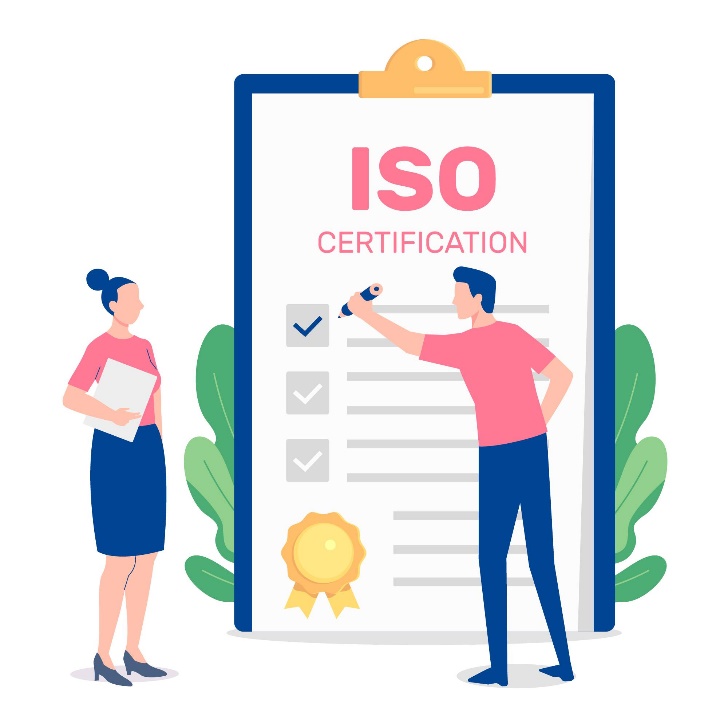I. Introduction to ISO Certification
A. What is ISO?
ISO, or the International Organization for Standardization, is an independent international body that develops standards to ensure the quality, safety, and efficiency of products, services, and systems. ISO standards are developed through consensus among experts from various industries and are recognized globally as benchmarks for quality and reliability.
B. Importance of ISO Certification
ISO certification is important for organizations seeking to demonstrate their commitment to meeting international standards of quality and efficiency. It signifies that a company’s products, services, or processes comply with specific ISO standards, enhancing customer confidence and opening up new market opportunities. ISO certification can also be a prerequisite for participating in certain tenders or contracts, especially in government or large corporate sectors where adherence to standards is crucial.
II. Understanding Different Types of ISO Standards
A. Overview of ISO 9001 (Quality Management)
ISO 9001 is one of the most well-known and widely implemented ISO standards globally. It focuses on quality management systems (QMS) and provides a framework for organizations to ensure consistent delivery of products and services that meet customer and regulatory requirements. ISO 9001 certification demonstrates an organization’s commitment to quality, customer satisfaction, and continuous improvement. Key elements of ISO 9001 include process management, customer focus, leadership commitment, and evidence-based decision making.
B. Exploring ISO 14001 (Environmental Management)
ISO 14001 addresses environmental management systems (EMS) and is designed to help organizations minimize their environmental footprint. This standard provides a systematic approach for identifying, managing, monitoring, and improving environmental performance across all aspects of business operations. ISO 14001 certification signifies an organization’s commitment to sustainability, pollution prevention, and compliance with environmental regulations. Key components of ISO 14001 include environmental policy development, planning, implementation, and evaluation of environmental performance.
C. Insights into ISO 27001 (Information Security)
ISO 27001 focuses on information security management systems (ISMS) and provides a comprehensive framework for protecting sensitive information and managing cybersecurity risks. This standard helps organizations establish and maintain robust security controls to preserve the confidentiality, integrity, and availability of information assets. ISO 27001 certification is crucial for organizations handling sensitive data, such as financial information, intellectual property, and personal data. Key aspects of ISO 27001 include risk assessment, security policy development, asset management, access control, and incident response planning.
D. Other Key ISO Standards and Their Relevance
Apart from ISO 9001, ISO 14001, and ISO 27001, there are numerous other ISO standards relevant to specific industries and aspects of business operations. Some notable examples include:
- ISO 45001 (Occupational Health and Safety): Focuses on ensuring a safe and healthy work environment, reducing workplace injuries and illnesses.
- ISO 50001 (Energy Management): Provides a framework for improving energy performance, reducing energy consumption, and optimizing energy use.
- ISO 22000 (Food Safety Management): Addresses food safety hazards in the food supply chain, ensuring the safety of food products.
- ISO 31000 (Risk Management): Offers guidelines for implementing effective risk management practices across organizations.
Each of these ISO standards contributes to organizational excellence, compliance, and sustainability within specific domains, enabling businesses to address diverse challenges and opportunities while maintaining international best practices. Understanding and implementing relevant ISO standards can significantly benefit organizations by enhancing performance, minimizing risks, and fostering continuous improvement.
III. Why Your Business Needs ISO Certification
A. Enhancing Credibility and Reputation
ISO certification enhances the credibility and reputation of your business by demonstrating your commitment to meeting international standards of quality, safety, and efficiency. Customers, partners, and stakeholders perceive ISO-certified organizations as reliable and trustworthy, leading to increased confidence in your products or services. This enhanced reputation can open up new business opportunities and strengthen existing relationships with customers and suppliers.
B. Improving Operational Efficiency
Implementing ISO standards often leads to improved operational efficiency within your business. ISO standards provide guidelines for streamlining processes, reducing waste, and optimizing resource utilization. By adhering to these standards, organizations can identify inefficiencies, implement best practices, and continuously improve their operations. Improved efficiency not only reduces costs but also enhances overall productivity and performance.
C. Meeting Customer Requirements
ISO certification is often a prerequisite for many customers, especially in industries where quality and reliability are paramount. Having ISO certification demonstrates your ability to consistently meet customer requirements and expectations. This assurance of quality and conformity to international standards can give your business a competitive edge and increase customer satisfaction, leading to repeat business and positive referrals.
D. Gaining Competitive Advantage
ISO certification can provide your business with a significant competitive advantage in the marketplace. It differentiates your organization from competitors who may not have achieved similar standards of quality and efficiency. ISO-certified businesses are often preferred by customers and preferred suppliers in tenders and contracts, especially in sectors where adherence to standards is critical, such as manufacturing, healthcare, and technology. This competitive advantage can lead to increased market share and revenue growth.
IV. Steps to Achieve ISO Certification
A. Preparing for ISO Certification:
Preparing for ISO certification begins with securing commitment from senior management and forming a dedicated project team. Adequate resources, including budget and personnel, should be allocated to support the certification process effectively. The project team plays a crucial role in coordinating and overseeing the implementation of ISO standards within the organization.
B. Selecting the Right ISO Standard:
Selecting the appropriate ISO standard(s) is a critical step that depends on the nature of your business, industry requirements, and customer expectations. Research and understand the specific requirements of the chosen ISO standard(s) to prepare for implementation. Consider factors such as quality management (ISO 9001), environmental management (ISO 14001), information security (ISO 27001), or other relevant standards based on organizational needs.
C. Gap Analysis and Initial Assessment:
Conduct a comprehensive gap analysis to assess current business processes, systems, and practices against the requirements of the selected ISO standard(s). This analysis helps identify areas where improvements are needed to achieve compliance with ISO standards. The initial assessment provides a clear understanding of the gap between existing practices and ISO requirements.
D. Developing and Implementing ISO Management Systems:
Based on the findings of the gap analysis, develop and implement ISO-compliant policies, procedures, and documentation within the organization. Ensure that new processes and systems align with the requirements of the chosen ISO standard(s). Provide necessary training and resources to employees to facilitate the adoption of ISO management systems effectively.
V. Common Challenges and How to Overcome Them
A. Resource Allocation:
One of the common challenges in achieving and maintaining ISO certification is resource allocation. Implementing ISO standards requires dedicated resources in terms of finances, time, and personnel. To overcome this challenge, it’s important for organizations to secure commitment from senior management to allocate adequate resources for the certification process. Properly budgeting and planning resources, including manpower and training, can help ensure that the ISO implementation project stays on track and achieves its objectives efficiently.
B. Resistance to Change:
Resistance to change is another challenge organizations may face when implementing ISO standards. Employees and stakeholders may resist adopting new processes or systems required for ISO compliance due to fear of the unknown or disruption to existing routines. To address resistance to change, organizations should prioritize communication and employee engagement throughout the ISO implementation process. Providing clear explanations about the benefits of ISO certification, involving employees in decision-making, and offering training and support can help alleviate resistance and foster a culture of acceptance and participation.
C. Maintaining Compliance Post-Certification:
Maintaining compliance with ISO standards post-certification can be challenging, especially as business environments evolve and regulations change. To sustain ISO compliance over time, organizations should establish robust monitoring and review mechanisms. Regular internal audits and management reviews are essential to identify any deviations or non-conformities and take corrective actions promptly. Continuous training and awareness programs for employees can also help ensure ongoing adherence to ISO requirements. Additionally, staying updated with changes to ISO standards and industry best practices is crucial to maintaining compliance and driving continuous improvement within the organization.
VIII. Conclusion
A. Recap of Key Points:
In conclusion, ISO certification plays a vital role in enhancing the credibility, efficiency, and competitiveness of organizations across various industries. Throughout this guide, we have explored the significance of ISO standards, the steps to achieve certification, common challenges, and strategies to overcome them.
ISO standards such as ISO 9001, ISO 14001, and ISO 27001 provide frameworks for quality management, environmental management, and information security, respectively. Achieving ISO certification not only improves operational efficiency but also demonstrates a commitment to meeting customer requirements and regulatory standards.
B. Encouragement to Pursue ISO Certification:
We strongly encourage organizations to pursue ISO certification as a strategic initiative to drive continuous improvement, enhance customer satisfaction, and gain a competitive advantage in the marketplace. ISO certification not only validates your organization’s commitment to quality and excellence but also opens up new opportunities for growth and expansion.
By obtaining ISO certification, organizations can establish themselves as industry leaders, improve operational processes, mitigate risks, and build trust with stakeholders. The journey towards ISO certification requires dedication, collaboration, and perseverance but the rewards in terms of improved performance and market reputation are well worth the effort.


